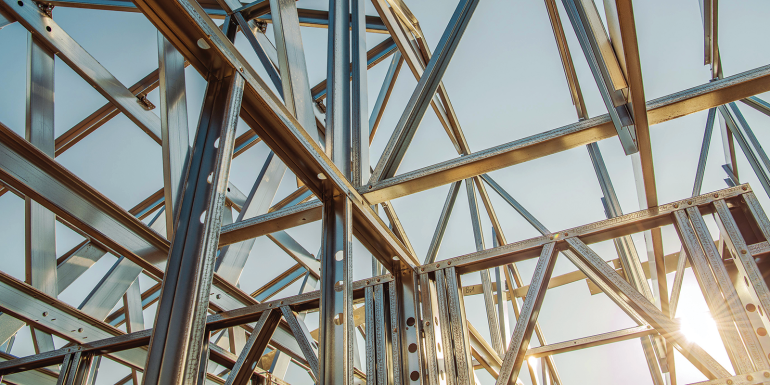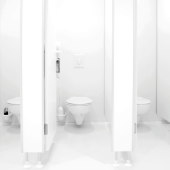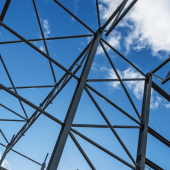Safety issues when adding PV panels to existing roofs

We look at a recent report about concerns over the knowledge and assessment standards for the installation of solar panels for multiple public sector buildings and schools.
A reporter’s organisation has recently been involved in reviewing calculations for the installation of solar photovoltaic (PV) panels on numerous public sector buildings and schools. Concern was raised about the lack of structural engineering knowledge and dangerous assumptions used in the assessments. The reporter has seen/reviewed calculations from multiple organisations, mainly solo practitioners and small building surveying firms.
A summary of the main issues encountered are:
- details of the existing structure and loading arrangement not included in calculations
- details of the proposed PV and loading arrangement system not being provided
- the weight of supporting frames and ballast to anchor the panels have not been included in calculations for additional loading to the roof
- no back-checking/assessment of existing structural members, liner trays or purlins to check they are adequate for the proposed loads
- offsetting the roof access loads without consideration of snow loads
- in some instances, the full access load has been offset, raising the question of how the panels are to be installed or maintained
- no consideration of localised snow drift caused by the panels creating new obstructions on the roof
- uplift wind forces on the panels are often ignored completely
- mixing of design codes, for example using Eurocode loading with British Standard member design and vice versa
- no checks on serviceability criteria for the roof, for example that no ponding will occur; and
- eroding the partial factors for loading as a way to justify the new loading.
The reporter has come across calculations using assumed values to offset the load. For example, a recent project had assumed the roof had a ceiling and services allowance of 0.25kN/m2, thinking this was an industry-standard value, and then used this to offset loading. There were no existing load plans available to validate the ceiling and services allowance for this project.
They also report that wind uplift forces, which could be critical in non-ballasted installations on lightweight roofs, are often ignored and most engineers’ reports only check for gravity load combinations.
Another concern is that the ballast arrangement on the roof is frequently being ignored or not properly considered in design. Typically, PV suppliers will concentrate ballast around panel edges due to high uplift forces. Most structural reports ignore this and average the total ballast load over the whole PV installation.
The reporter has recently seen several proposed installations where panels are to be attached to an existing timber roof with gang-nail-type trusses. While a global check is often performed on the roof structure, checks on the fixings between the roof structure and PV mounting frames are often omitted. The reporter has often found this detail to be critical in terms of fixing layout and edge distances as highlighted in BRE Digest 489 Wind loads on roof-mounted photovoltaic and solar thermal systems.
Issues have arisen where clients were not advised on the risks that need to be included in the building’s Health and Safety file – for example, advising the client that roof access must be limited or that no additional services can be supported by the roof.
They have also noted that some reports contain statements/assumptions that they believe to be unsafe or dangerous. The following were contained in a recent report:
- “Given the roof is only loaded with snow for short periods, we do not consider the loadings to be an issue”; and
- “To summarise, the structure has a comfortable factor of safety built into its design and a sufficient capacity for any minor overloading scenarios which may occur.”
Comments
It is good to see this reporter’s firm is checking calculations for such installations, although worrying to observe the number and extent of the problems found. There have been a number of previous CROSS reports on PV panels, and these can be found on the CROSS website along with a SCOSS Alert issued in 2016: Photovoltaic installations – structural aspects (bit.ly/PV_Installation).
BRE Digest 489 Wind loads on roof-mounted photovoltaic and solar thermal systems (bit.ly/PVWindLoad), as referred to above, provides very useful design guidance, based on EN 1991 and the UK NA, for calculating wind forces. Contractors may be familiar with electrical installation, and there are guides on this – for example, Guide to the Installation of Photovoltaic Systems (bit.ly/PVInstallGuide) from the Microgeneration Certification Scheme. This guide does not cover the structural implications for the roof. The Scottish Government published Low carbon equipment and building regulations – a guide to safe and sustainable construction – Photovoltaics (bit.ly/ScotPVGuide) in 2012, which also contains advice on installation.
Given the growing practice of installing panels and the generic faults in design and construction, there should be a structural engineering guide, and possibly a Code of Practice, for the design and installation of such panels. This should cover both new buildings and retrofits on existing buildings. After installation, there should be a certificate to confirm compliance with guidelines.
Note should also be taken of the risks with the manual handling and work at height issues associated with installing and maintaining solar panels. There have been numerous incidents of workers falling through, or from, roofs during such work. Roofs must be left in a state where maintenance can safely be undertaken. HSE in Northern Ireland have a web page on installing solar panels safely (bit.ly/SafeSolarInstallation), which gives helpful information. The Working at Height Regulations – and, by implication, compliance with BS 5975 for temporary works – are also relevant.
Generic faults in design and installation appear to be widespread, with structural safety and maintenance issues that may be costly to resolve in future. With increased attention on the green agenda, the use of – and associated potential problems with – these installations may be expected to increase.
Key learning outcomes
For civil and structural design engineers:
- structural design must comply with Approved Document A
- load effects of snowdrifts and wind uplift forces on the roof structure should be carefully considered
- BRE Digest 489 Wind loads on roof-mounted photovoltaic and solar thermal systems provides very useful design guidance, based on EN 1991 and the UK National Annex for calculating wind forces; and
- there have been a number of previous CROSS reports on PV panels, and these risks were highlighted in a Standing Committee on Structural Safety (SCOSS) Alert in 2016: Photovoltaic installations – structural aspects.
For the building team:
- on existing roofs, make sure that the structural aspects have been considered
- be aware that panels can add load to existing roofs
- be aware of the risks of working on existing roofs; and
- inspection by a competent person should be carried out to ensure the works are installed in accordance with the design intent.
For industry:
- note that CROSS recommends there should be guidance upon structural design and installation of PV panels for both new and existing buildings.
Image credit | Alamy







